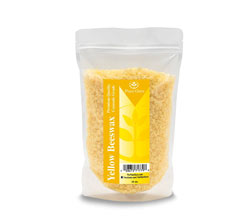It is hard to ignore the wonders of natural waxes. They can be used to provide extra stability to your DIY lip balms, creams, lotions, and more. If you wish to learn more about today’s available wax varieties such as beeswax, candelilla wax, emulsifying wax, etc., you have come to the right place. Let’s get right down to business!
- Where Does Candelilla Wax Come From?
- What Is Yellow Beeswax?
- What Is White Beeswax?
- What Is Emulsifying Wax?
- What Does Emulsifying Wax Do To Hair?
- What Does Candelilla Wax Smell Like?
- Is Yellow Beeswax Safe?
- Is White Beeswax Safe?
- Is Candelilla Wax Vegan?
- Is Candelilla Wax Safe?
- How Is Emulsifying Wax Made?
- How Can I Use Candelilla Wax?
- Does Emulsifying Wax Expire?
- Does Emulsifying Wax Clog Pores?
- Does Emulsifying Wax Cause Acne?
- Does Candelilla Wax Clog Pores?
- Can You Substitute Emulsifying Wax For Beeswax?
- Can I Use Emulsifying Wax In Lip Balm?
- Can Emulsifying Wax Be Used As Beeswax?
Where Does Candelilla Wax Come From?
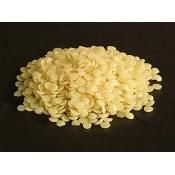 Candelilla is a wax derived from the leaves of the small Candelilla shrub native to the southwestern United States, Euphorbia antisyphilitica and Euphorbia cerifera, from the family Euphorbiaceae. It is aromatic, brittle, hard and yellowish brown. It is blended with other waxes to harden them.
Candelilla is a wax derived from the leaves of the small Candelilla shrub native to the southwestern United States, Euphorbia antisyphilitica and Euphorbia cerifera, from the family Euphorbiaceae. It is aromatic, brittle, hard and yellowish brown. It is blended with other waxes to harden them.
One of the types of wax you will come across is candelilla wax. This type of wax does not come from bees; it is a derivative of a small shrub known as the candelilla. The shrub is native to northern Mexico as well as the southwest of the United States. This type of wax is usually yellowish to brownish in color, aromatic and opaque to translucent to light. It is also noted to be harder and more brittle compared to beeswax.
This type of wax has many industrial as well as cosmetic uses. Some of the industrial uses include the manufacture of chewing gum and as a glazing agent. In the cosmetic industry, candelilla wax is used as an ingredient in many products including lip balms and some types of lotions.
Some of the cosmetic benefits of candelilla wax include the fact that it will not clog pores, and also has the effect of soothing skin and keeping it hydrated. In addition to that, candelilla wax also has an anti-inflammatory effect which may be beneficial in conditions such as eczema or dermatitis.
What Is Yellow Beeswax?
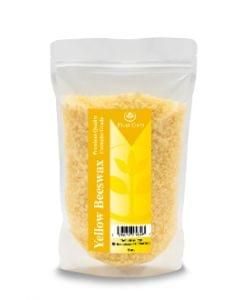 Heated and cleaned to mesh out debris, yellow beeswax is a crude product which is obtained from the honeycomb. It can be in different shades of yellow, ranging from light to dark variation. This beeswax version is perfect for candle-making.
Heated and cleaned to mesh out debris, yellow beeswax is a crude product which is obtained from the honeycomb. It can be in different shades of yellow, ranging from light to dark variation. This beeswax version is perfect for candle-making.
Initially, when beeswax is produced, it is clear in color. As time goes by, however, it becomes more yellow or even brown as more and more pollen is brought into the hive by other worker bees. This is what is usually extracted and then used for many purposes including formation of other types of wax and creation of beauty products.
Yellow beeswax is in its most pure and natural form since it is usually not altered at all in this form. Usually found in pellets or bars, yellow beeswax has no additives whatsoever added into it. There are many benefits of yellow beeswax, particularly as a beauty product.
The unclarified beeswax has many properties, including antibacterial, anti-inflammatory, germicidal, antioxidant and antiallergenic uses. In addition to that, it also locks in moisture to the skin, making it soft. Yellow beeswax can also be used for industrial applications in addition to the cosmetic ones as well. For instance, it can be used to produce candles which have a honey aroma. Yellow beeswax candles have been noted to burn brighter than other types of candles, which is an additional benefit.
What Is White Beeswax?
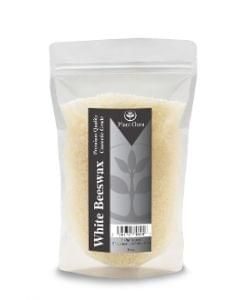 The wax segregated from the hive bee’s honeycomb is the white beeswax. With the exposure of the thin layers to the action of moisture, sunlight and air, it is deodorized and bleached. The wax comes with a granulated form and it gets the white color without the use of chlorine or chemicals.
The wax segregated from the hive bee’s honeycomb is the white beeswax. With the exposure of the thin layers to the action of moisture, sunlight and air, it is deodorized and bleached. The wax comes with a granulated form and it gets the white color without the use of chlorine or chemicals.
White beeswax is called so on account of its color. Typically, most people expect natural beeswax to be yellow or orange in color. However, when produced, the beeswax is initially white in color. Through the addition of other compounds such as pollen, the wax then changes color to yellow or orange.
There are other factors that will influence the color of the beeswax. One of these is the length of time it is left in the hive. Typically, beeswax that stays in the hive for longer tends to have a darker color. When taken out of the hive early on, it is likely to be white in color since it will not have had time to accumulate other discoloring compounds.
In addition to that, other issues that affect the color of the beeswax include how clean it is as well as the temperature it is kept at. The higher the temperature, the darker the beeswax. All in all, this means that when you come across white beeswax, you should not assume that it is bleached, as it is possible to have white natural beeswax.
What Is Emulsifying Wax?
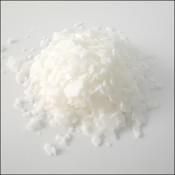 Emulsifying wax is a white wax solid with a slight fatty alcohol smell. A wax material is treated with a detergent, binding the water and oil together into a smooth emulsion. The ingredients in Emulsifying Wax NF include Steareth-20, PEG-150 Stearate, Polysorbate 60 and Cetearyl Alcohol.
Emulsifying wax is a white wax solid with a slight fatty alcohol smell. A wax material is treated with a detergent, binding the water and oil together into a smooth emulsion. The ingredients in Emulsifying Wax NF include Steareth-20, PEG-150 Stearate, Polysorbate 60 and Cetearyl Alcohol.
The emulsifying wax is a cosmetic product that is used to ensure that compounds are bound together easily, thus resulting in a mixture that will be beneficial for your skin. For instance, fatty chemicals may be necessary to keep the skin smooth. At the same time, however, the product will need to combine with water so as to keep the skin hydrated. Without emulsification, this process is not possible and the dual benefits are missed.
The nature of the cosmetic products made will depend on the quality of the emulsifying wax. When high quality materials and strict quality control methods are used during the creation, you will end up with a product that will be excellent for the skin.
This means that when you buy emulsifying wax for cosmetic purposes, you should insist on high quality. This can only be done by taking your time to find a source that places quality above all else. You could also rely on user reviews to identify some of the best emulsifying waxes out there so that you can get more value for money. At the end of the day, you will be glad that you used it since its effects are always appreciated.
What Does Emulsifying Wax Do To Hair?
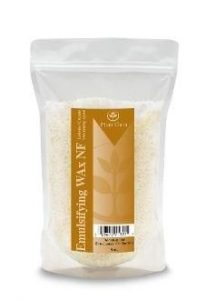 Emulsifying wax helps in improving the texture and consistency of the final product without leaving any oily film on the hair. It can also be utilized to make thin or thick emulsions, based on the concentration at which it is used.
Emulsifying wax helps in improving the texture and consistency of the final product without leaving any oily film on the hair. It can also be utilized to make thin or thick emulsions, based on the concentration at which it is used.
However, emulsifying agent has properties that make it even more versatile than this. For instance, the fact that it is not as hard as some other types of wax means that it can be used on the hair. In such instances, it will end up having positive effects as well.
One of these is it will also keep the hair hydrated. One of the common problems that people have with hair is easy drying. This leads to breakage and dulling of the hair. When emulsifying agents are applied on the hair, they retain the water within the hair, thus ensuring that it stays hydrated throughout the day. This is especially important in environments where the rate of evaporation is likely to be very high.
By applying emulsifying wax on hair, you will end up with hair that is longer due to less risk of breakage. It will also look thick and have a sheen, properties that are all associated with healthy and attractive hair. Whether you have short or long hair, using emulsifying wax on it will have these benefits.
What Does Candelilla Wax Smell Like?
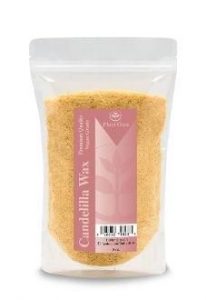 Candelilla wax is the most commonly used wax when looking for an alternative. This unrefined wax is brittle and aromatic with a very decent scent and a deep yellow colour. It has some of moderately pleasant sweet smell, which is distinctive and mild.
Candelilla wax is the most commonly used wax when looking for an alternative. This unrefined wax is brittle and aromatic with a very decent scent and a deep yellow colour. It has some of moderately pleasant sweet smell, which is distinctive and mild.
One of the products you are likely to come across is candelilla wax. Unlike beeswax, candelilla wax does not come from bees but is extracted from the leaves of a plant that is native to northern Mexico. When done properly, the extraction process will not result in the addition of any synthetic compounds in the wax.
The wax has many benefits, some of which include the fact that it locks in moisture and keeps the skin smooth and supple. However, one of the questions that you may have is what it smells like. This type of wax has a mild scent which is pleasantly sweet. The fact that it is not overwhelming makes it perfect for cosmetic use. Most people will find the smell of candelilla wax to be pleasing and even relaxing.
Of course, this is only when the wax is not combined with other synthetic compounds. When using the wax, there are some other herbs that may be mixed with it to give it specific scents. In such cases, the candelilla wax smell depends on what is added to the mixture.
Is Yellow Beeswax Safe?
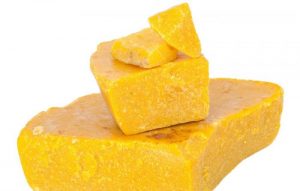 Since beeswax is naturally produced in the beehives by the honeybees, it is non-toxic in nature and is generally considered safe. People who are allergic to honey may suffer from allergic reactions if the wax is taken in large quantities.
Since beeswax is naturally produced in the beehives by the honeybees, it is non-toxic in nature and is generally considered safe. People who are allergic to honey may suffer from allergic reactions if the wax is taken in large quantities.
By definition, yellow beeswax is not clarified, which means that it has not been altered in any way. This is the beeswax that comes directly from the bees, without addition or removal of any compounds. Yellow beeswax has many uses, including as an anti-allergenic product as well as to condition skin and makes it softer.
One question that many people will have before using yellow beeswax is whether it’s safe to use or not. The fact that a product is natural does not mean that it is safe; there are many natural products that are toxic or harmful to humans. Fortunately, yellow beeswax that has been extracted properly and handled in the right manner has not been shown to have any harmful effects.
As long as the beeswax is still pure, you can use it for many beauty and health purposes and expect no negative health effects. You can even use the yellow beeswax to make candles, which will turn out to have an excellent aroma. Of course, this means that if you want to make use of yellow beeswax, you would need to buy it from a vendor with a good reputation. They will have made sure that the product is genuine, and therefore safe.
Is White Beeswax Safe?
 Beeswax carries antibacterial, antiviral and anti-inflammatory properties that are important in fighting infections. It is generally considered safe to use unless you are allergic to honey related products, which is very rare. It is safer when taken by mouth rather than direct application to the skin.
Beeswax carries antibacterial, antiviral and anti-inflammatory properties that are important in fighting infections. It is generally considered safe to use unless you are allergic to honey related products, which is very rare. It is safer when taken by mouth rather than direct application to the skin.
When buying beeswax for cosmetic or other purposes, you may run into what is known as white beeswax. White beeswax can be natural or can be the product of bleaching natural beeswax. Bleaching is sometimes done to change the color of the wax since most beeswax naturally has an orange or yellow color.
If you intend to use white beeswax, you may be wary of the safety profile of the product. When the beeswax is made white through bleaching, it may end up damaging your skin. This is particularly so if the bleaching was not done properly, thus leading to retention of some of the chemicals in the bleach within the wax. These will come into contact with the skin and cause a chemical reaction.
However, when the white beeswax is white and not bleached, it is very safe. The key to using white beeswax without having any safety issues. In order to ensure that the white beeswax you are using is actually natural, you will have to buy it from an institution that you can trust. You also need to ensure that the brand you buy is also trustworthy. When all these checks are done, you will find that natural white beeswax is actually very safe, and will have the expected results when used.
Is Candelilla Wax Vegan?
 Since the wax is derived from the leaves of the Mexican shrub Euphorbia antisyphilitica, it is a plant based wax and an ideal vegan alternative to beeswax. The unrefined wax is rich in nutrients and helps in binding the ingredients together, creating a texture that can be easily absorbed into the skin.
Since the wax is derived from the leaves of the Mexican shrub Euphorbia antisyphilitica, it is a plant based wax and an ideal vegan alternative to beeswax. The unrefined wax is rich in nutrients and helps in binding the ingredients together, creating a texture that can be easily absorbed into the skin.
If you are vegan, the use of beeswax may cause an issue for you since it is essentially an animal product. Despite the fact that beeswax has many benefits including very good skin hydration and protection, the fact that it comes from bees means that it is usually avoided by vegans.
Fortunately, candelilla wax has nothing to do with animals, which means that it can be considered a vegan product. For one, it is extracted from a plant, rather than being the product of an animal. In addition to that, the extraction process of candelilla wax does not include the use of any animal product. This means that the end product is essentially vegetable in nature.
Candelilla wax therefore offers an excellent alternative to beeswax for strict vegans. The good thing is that though there are some differences in the chemical nature of beeswax and candelilla wax, you will still get the same benefit from both. Some of these include excellent protection of the skin from the elements, as well as reducing inflammation of the skin. It’s also easy to use as well. If you are a vegan and are interested in candelilla wax, it would be wise to buy it from a source with very good quality standards, as this is the only way you will be assured that it’s vegan-friendly.
Is Candelilla Wax Safe?
 Being highly rich in nutrients, Candelilla wax gets easily absorbed into the skin, allowing it to prevent moisture loss by acting as a barrier. It is non-irritant, non-toxic and safe, without any reported side effects or concerns with the ingredients.
Being highly rich in nutrients, Candelilla wax gets easily absorbed into the skin, allowing it to prevent moisture loss by acting as a barrier. It is non-irritant, non-toxic and safe, without any reported side effects or concerns with the ingredients.
Fortunately, this is something that you don’t have to worry about when using natural candelilla wax. This type of wax has been proven to be very safe. This is primarily due to the fact that it does not contain any harmful products in it.
In addition to that, the chemical makeup of the wax means that it does not penetrate into pores leading to blockage. The latter is a problem that will lead to skin eruptions such as blackheads and whiteheads. You can therefore use candelilla wax either on its own or in combination with other natural cosmetics for a long time, and expect no ill effects.
Of course, this depends on a number of factors, the most important of which is the extraction and handling of the wax. These processes should be done in such a manner that extra chemicals are not added to the wax. Addition of dangerous chemicals to candelilla wax will lead to a reaction with the skin. This will then lead to skin damage and in some cases damage to other organs as well. Making sure that you buy candelilla wax that is 100% natural is essential to making sure that you maximally benefit from it while at the same time being safe.
How Is Emulsifying Wax Made?
 On treating a petroleum-based wax or a vegetable wax with a detergent such as polysorbates or sodium dodecyl sulfate, emulsifying wax is created. The water and oil binds together to form a smooth emulsion. A white waxy solid is formed with a slight smell of fatty alcohol.
On treating a petroleum-based wax or a vegetable wax with a detergent such as polysorbates or sodium dodecyl sulfate, emulsifying wax is created. The water and oil binds together to form a smooth emulsion. A white waxy solid is formed with a slight smell of fatty alcohol.
The role of emulsifying waxes is to keep the combination of water and oils together. In this way, it acts as a binding agent in most cosmetic agents. The result of this is that when applied on skin or hair, the wax will help in trapping of water within the hair, thus resulting in a shiny and more healthy look.
The manufacture of emulsifying waxes involves the combination of bleach and plant fats. The right plant fats have to be chosen for the emulsifying wax to have the right properties, such as the right feel. In addition to that, the combination of these two products should be done carefully in order to reduce the risk of coming up with a product that will actually harm the skin and hair rather than protecting it and making it look more attractive.
Though the process of making emulsifying wax seems simple enough, all the quality control protocols have to be followed so as to ensure that the end result is of high quality. This means that if you are making it yourself, you have to be careful and have the right instructions in mind.
If you are buying readymade emulsifying wax, ensuring that the manufacturer is of high quality will result in a much better emulsifying wax. This means that using tried and tested brands are important.
How Can I Use Candelilla Wax?
 Candelilla Wax is used as a food additive or a glazing agent in food industry. However, it finds extensive application in the cosmetic industry, as a component of lotion bars and lip balms. It can be ideally used as an alternative to beeswax and carnauba wax.
Candelilla Wax is used as a food additive or a glazing agent in food industry. However, it finds extensive application in the cosmetic industry, as a component of lotion bars and lip balms. It can be ideally used as an alternative to beeswax and carnauba wax.
If you are interested in using candelilla wax, you would first want to make sure that it is 100% natural. You should buy from stores that are known to keep quality high. This is the only way to ensure that the candelilla wax you purchase will be of high quality and will not do damage to your skin.
One of the benefits of candelilla wax is the fact that you can use it in so many ways, so you can customize the use. One of the common uses of candelilla wax is as a lip balm. To do this, you only need to apply the wax on your lips. This will protect the soft skin from the elements, and will also keep in the moisture. This will result in much softer lips for the rest of the day.
In addition to this common use, you can also use candelilla wax as a type of lotion as well. You can apply the wax to other parts of your skin as you would other types of oil, and it will have the effect of locking in moisture, protecting your skin and also reducing inflammation.
Does Emulsifying Wax Expire?
 Each emulsifying wax has a different shelf life, as they are different in specification. One should check for it before buying. The waxes start creaming when they go bad, hence it is essential to have knowledge of the most important ingredient in a balm or lotion.
Each emulsifying wax has a different shelf life, as they are different in specification. One should check for it before buying. The waxes start creaming when they go bad, hence it is essential to have knowledge of the most important ingredient in a balm or lotion.
In addition to that, emulsifying wax also has the benefit of keeping the skin hydrated and protected. The fatty component of the wax ensures that not much water leaves the skin. This means that the skin will keep on being hydrated throughout the day, making it healthier and softer as well.
A common concern for people who use emulsifying waxes or who intend to start using them is if they expire. There are some natural cosmetic products that can stay for a very long time without going bad. Emulsifying wax is one of these. After manufacture, the wax can remain usable for a long time. However, it will not stay in this form; there will always come a time when it will expire. This depends on the manufacturing process as well as how the wax was stored.
This means that essentially, all emulsifying waxes have an expiration date. However, there are ways of making sure that they last longer. These include storing them in cool, dry conditions in the right containers. In addition to that, you should buy well-made emulsifying waxes, as the quality of manufacturing will also affect the longevity of the product.
Does Emulsifying Wax Clog Pores?
 Yes! Oils generally get absorbed directly into the skin and rarely block pores, but wax emulsifiers do clog pores. You will find various types of emulsifying wax in water-based moisturizers, which can clog the pores and block the skin from releasing sweat.
Yes! Oils generally get absorbed directly into the skin and rarely block pores, but wax emulsifiers do clog pores. You will find various types of emulsifying wax in water-based moisturizers, which can clog the pores and block the skin from releasing sweat.
One of the types of products you can come across is emulsifying wax. This is a type of wax that is made through a chemical reaction involving plant fats and bleaching agents. The resulting wax is similar to other types of wax, such as beeswax. However, it has extra properties that make it the perfect agent for cosmetic emulsification. For instance, it can be used in the manufacture of body oils and even lip balm.
The fact that it is derived from fats might make some people alarmed, as this might mean that it clogs pores. However, the truth is that emulsifying wax only minimally clogs pores, which means that it can be used without fear of this.
People for whom this property is most important include those who have oily skin. In such cases, it is important to keep your pores open since this will ensure that all the oil produced is transferred to the surface. If the pores are clogged, the excess oil will quickly result in the formation of pimples and breakouts. You can therefore use emulsifying waxes without the fear of this happening.
Does Emulsifying Wax Cause Acne?
 Any process of waxing removes some skin from the surface, leaving the pores exposed. If the area is touched with anything post-waxing, it can easily cause acne and breakouts. The oils and dirt from your hands can completely creep into the pores when they are open.
Any process of waxing removes some skin from the surface, leaving the pores exposed. If the area is touched with anything post-waxing, it can easily cause acne and breakouts. The oils and dirt from your hands can completely creep into the pores when they are open.
One of these is emulsifying wax. This is a product that can be used as is or to produce other cosmetics on your own. It is typically applied on the skin to keep it soft and supple. This is by locking up the moisture in the skin, keeping it hydrated. It also prevents the skin from being damaged by external elements.
A typical question you might ask if you are interested in using emulsifying wax is whether it causes acne or not. The truth is that due to the mild nature of the wax, it does its job without causing any chemical stress on the skin. It is the latter which could lead to acne, which means that even regular use of emulsifying wax will not lead to the formation of acne.
In addition to that, the wax does not clog pores. Formation of clogs in pores is an essential step in the evolution of acne. Preventing this from happening will go a long way in keeping your skin acne-free. The fact that emulsifying wax is free of this property makes it ideal for use even if you want to keep acne at bay. Finally, the wax also has anti-inflammatory effects as well. Acne has a huge inflammatory component, which means that when you use emulsifying wax when you have it, it is likely to actually reduce.
Does Candelilla Wax Clog Pores?
 Having been widely used in moisturizers, cleansing creams and eye creams, it does clog the pores allowing the bacteria to thrive creating whiteheads and blackheads. They also choke the skin, which can cause enlarged pore problems in the future, leading to further complications.
Having been widely used in moisturizers, cleansing creams and eye creams, it does clog the pores allowing the bacteria to thrive creating whiteheads and blackheads. They also choke the skin, which can cause enlarged pore problems in the future, leading to further complications.
This type of wax can be used cosmetically either on its own or as an ingredient in some other product. When it’s a major ingredient or when used on its own, one of the issues you may be keen on is whether it’s comedogenic or not. Comedogenic products are those that clog pores, resulting in the formation of pimples and blackheads. This is particularly so if you have oily skin.
Avoiding cosmetic products that will block your pores is therefore essential to keeping it look soft and clarified. Fortunately, candelilla wax is not on the list of comedogenic products. When used either on its own or in combination with other products, it turns out that candelilla wax does not clog pores.
This means that you can use it comfortably without the risk of having breakouts later. The fact that it does not clog pores also means that you can use it in the long term without fear that it will damage your skin. Of course, the candelilla wax needs to be of high quality for you to benefit maximally from its qualities.
Can You Substitute Emulsifying Wax For Beeswax?
 No! Emulsifying wax can only be replaced with an emulsifier. Beeswax is in no way an emulsifier. One can add borax to beeswax to make an emulsion, but then there will only be 1:1 ratio of water to oils, making for a greasy lotion.
No! Emulsifying wax can only be replaced with an emulsifier. Beeswax is in no way an emulsifier. One can add borax to beeswax to make an emulsion, but then there will only be 1:1 ratio of water to oils, making for a greasy lotion.
One of the common questions is whether this type of wax can be used in place of beeswax. Beeswax is one of the most popular cosmetic agents in many parts of the world. However, there are times when you may not be able to use beeswax, or not have access to it. In such cases, you can use emulsifying wax instead of beeswax.
For you to get the same benefits, there are a few key points you have to consider. The most important is that the emulsifying wax you use has to be of high quality. This means that all the steps from the selection of the plant fats to the distribution of the emulsifying wax have to be done correctly. If so, you will end up with a product that has the same benefits as beeswax.
If you are buying from a retailer, always make sure that the brand of emulsifying wax you are getting is of high quality. Simply getting reviews from other users is one of the most effective ways of getting this information accurately. In addition to that, you can also read reviews from specialists such as beauty columnists about them.
Can I Use Emulsifying Wax In Lip Balm?
 Lip products usually contain butters, waxes and oils. Emulsifier will be needed, once a water soluble ingredient is introduced. You are on the way to create a lotion when you start emulsifying oils and water. A preservative may not be necessary since lip balm does not contain water.
Lip products usually contain butters, waxes and oils. Emulsifier will be needed, once a water soluble ingredient is introduced. You are on the way to create a lotion when you start emulsifying oils and water. A preservative may not be necessary since lip balm does not contain water.
Waxes can be used for making many products. One of the most common of these is lip balm. Waxes are popular as lip balms on account of the fact that they are very good at locking in the water close to the skin. This means that throughout the day, the skin will be well hydrated. This is a property that is evident in emulsifying wax, which means that it can be used as a lip balm even when not combined with any other material.
Locking in moisture close to the lips is an important benefit of emulsifying wax. By doing this, the constant hydration of the skin keeps the skin soft and supple. This is very important because the skin on the lips is very thin. This means that when exposed to the elements, it is likely to lose a lot of water through evaporation and other ways. This is why when people are dehydrated, one of the first things that will happen is the skin on the lips becoming more dried up.
All in all, using emulsifying wax as a lip balm is a wise and effective way of keeping skin hydrated.
Can Emulsifying Wax Be Used As Beeswax?
 Beeswax is a cosmetic ingredient popularly known as an emollient, for its soothing and healing properties, and for the color, it imparts to cosmetic products, as a natural emulsifier. However, it is not an emulsifier, and an emulsifying wax cannot be used as a beeswax either.
Beeswax is a cosmetic ingredient popularly known as an emollient, for its soothing and healing properties, and for the color, it imparts to cosmetic products, as a natural emulsifier. However, it is not an emulsifier, and an emulsifying wax cannot be used as a beeswax either.
One of the most popular types of waxes out there is beeswax. This is popular on account of the fact that it is easy to obtain, as well as the fact that it’s cheap in most cases. In addition to that, the effects of beeswax are tried and tested, so you can be sure that you will be getting value for money when you start using it.
However, there are some reasons why some people might want to consider alternatives to beeswax. For instance, you may be vegan, or you may be interested in a type of wax that has a different odor. In such cases, you can try out other types of wax such as candelilla wax, or even emulsifying wax.
Emulsifying waxes are synthetically made using plant fats. This means that they contain no animal products, and for this reason can be used by vegans. In addition to that, emulsifying waxes can also be further modified such as through the addition of other natural products for specific results such as a specific smell.
If you are interested in using wax as part of your cosmetic regimen, you should consider trying out emulsifying wax in place of beeswax. It does work, and for some people is a better alternative.


